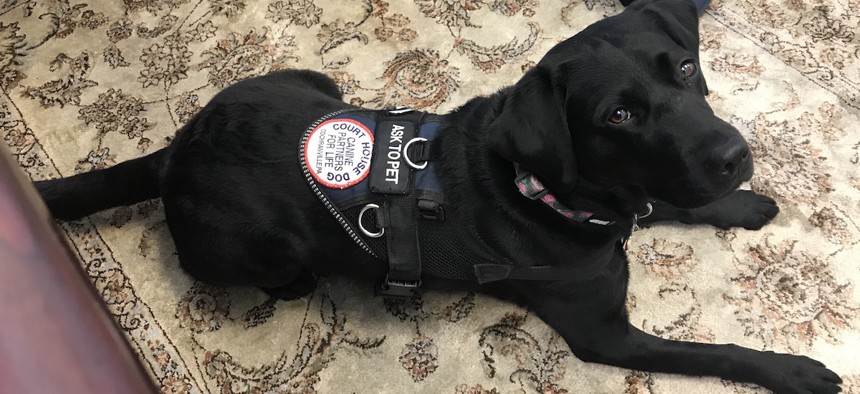Navigating the Justice System, Victims Find Comfort with Courthouse Dogs

Ramona, a 2-year-old black Labrador retriever, works with victims and witnesses at the Lehigh County Courthouse in Pennsylvania. Kim Silvestri
Courthouse companion dogs offer emotional support for victims and witnesses in 39 states.
After witnessing a murder outside of her window, a teenage girl in Lehigh County, Pennsylvania, decided to testify about what she’d seen. But even talking with officials before a court hearing was scary and unnerving.
“She was an excellent witness and she wanted to do the right thing, but she was terrified,” said Kim Silvestri, victim witness coordinator at the Lehigh County district attorney’s office. “She was meeting with the district attorney and a detective, and she was struggling.”
So officials brought in Ramona, a 2-year-old black Labrador retriever who serves as the courthouse’s companion dog. The girl “just hung onto Ramona,” Silvestri said. “You could see she was just pouring all of her emotion into Ramona. It was so helpful for her.”
Ramona is one of 201 dogs working in courthouses in 39 states, helping victims and witnesses—both children and adults—feel more comfortable while navigating the judicial system. Most are bred to be service dogs but diverted in their training when their size or personality indicates that they’d be better suited for companion work.
“Facility dogs are working dogs that are specially chosen because of their calm demeanor and ability to work in a high stress environment, thereby decreasing the risk of creating legal issues,” according to the Washington state-based Courthouse Dogs Foundation. “When their work day is over they go home with their primary handler and are ‘off duty.’”

Ramona came to the Lehigh County Courthouse in 2017 from Canine Partners for Life, a service-dog training and placement organization in Chester County, Pennsylvania. She trained there for two years, learning basic obedience and socialization before handlers evaluated her stature and personality and decided she would do best as a courthouse companion, said Tonya Guy, the nonprofit’s associate director of communications.
“A lot of times, we’ll look for smaller dogs, which can be more comforting to people, especially children, as they’re going through a difficult and traumatic time,” Guy said. “We also look at dogs that are very social, because we want them to be able to interact with a variety of people. Courthouse dogs are working with different victims and witnesses, sometimes multiple people every day. And we want a dog that’s calm, because they’re primarily there to be a friend and comfort for people.”
Once trainers identify a possible courthouse dog, they tailor a dog’s skills to the job, teaching “go say hi” (greeting a stranger) and “visit” (having the dog lay its head on someone’s leg or crawl into a lap, producing a steadying, calming effect). Since 2010, Canine Partners for Life has placed service dogs with four courthouses in Pennsylvania, with several more on a wait list.
Each courthouse pays a $600 donation—Lehigh County used drug forfeiture money—and agrees to train three staff members to work with the dog, including a primary handler who will house and care for the animal. The program continues to gain popularity due to its effectiveness, Guy said, particularly with juvenile victims and witnesses.
“A lot of times the children they’re meeting with have been abused or are the victim of a really horrific crime, and sometimes they’re not even willing to share their story,” she said. “When they bring the dog in, they’ve gotten the children to tell the story to the dog, or the dog helps relax them. In some courthouses they’re also allowed to have the dog go on the stand, which helps calm them throughout the process.”
The presence of dogs during trials has sometimes drawn criticism from defense attorneys, who argue that their presence can prejudice a jury against a defendant.
“The fact that a child needs a therapy dog is already a signal to the jury that there’s something they need therapy for,” Connecticut public defender George Flores told the Associated Press. “A child is sympathetic already. Give a child a dog and they’re much more sympathetic.”
To guard against that prejudice, courthouse dogs are typically brought into courtrooms and concealed beneath the witness stand before a jury enters. But even when they're visible, the impact may be less than anticipated—a 2016 study by researchers at Wofford University found that “contrary to popular beliefs and our own predictions,” jurors were not swayed one way or the other by having a dog in the courtroom.
Still, Silvestri is aware of the concern. Ramona has yet to appear at a trial—most cases end in plea bargains before they progress to that point—but she knows a special command (“under, down, stay”) that would get her into position out of sight of the jury box if a witness were called to testify.
So far, Ramona's work has taken place in meeting rooms, supporting victims while they tell their stories to attorneys and investigators. Last year, Ramona worked with about 80 victims; so far this year, she’s spent time with 18, many of them more than once. She works with adults and kids and has success with both, though there's something special about her work with children, particularly those who have been victims of sexual assault, Silvestri said.
"Your heart breaks for these kids who have to come in and talk to us, because we're strangers. And no matter how skilled or nice or comforting we are, an animal just adds that extra something," she said. "When we tell them they have to come back—because they have to do this multiple times—usually that's the last thing they want to hear. But the first kid Ramona worked with, when we told him he had to come back, he said, 'Yes!' And that's really why we did this."
Kate Elizabeth Queram is a Staff Correspondent for Route Fifty and is based in Washington, D.C.

NEXT STORY: Oklahoma Tries New Strategy and New Target in Opioid Lawsuit





